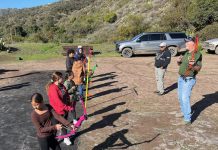It’s lobster season in California—and, unfortunately, lobster-poaching season.
And Catalina is a hotspot for poachers.
Andrew Hughan, a spokesman for DFG, identified Catalina as one of the areas where poachers are actively taking lobsters during recent interviews with the news media.
“We probably write 10 tickets a month for various lobster violations in and around Catalina,” Hughan said.
It’s lobster season in California—and, unfortunately, lobster-poaching season.
And Catalina is a hotspot for poachers.
Andrew Hughan, a spokesman for DFG, identified Catalina as one of the areas where poachers are actively taking lobsters during recent interviews with the news media.
“We probably write 10 tickets a month for various lobster violations in and around Catalina,” Hughan said.
“We have a patrol boat out there a lot,” Hughan said.
A Fish and Game patrol boat, the Thresher (as in thresher shark), visits the Island area three times a week as part of its regular patrol.
Hughan has been on the Thresher when wardens have caught poachers in the act—which is the only way they can get a conviction. That makes prosecution difficult.
Hughan said that during lobster season, divers will take lobsters from licensed fishing traps. During the off season, divers will take lobsters straight from the ocean.
Hughan said the poachers are almost exclusively sport fishermen. He said the commercial fishermen are generally compliant.
Spiny lobster fishing season began in early October.
California spiny lobsters are crustaceans that are common from Point Conception to Baja California. Lobster season generally opens the first week of October through about March 15. California spiny lobsters are slow-growing animals that biologists estimate take as long as seven years to grow to legal size. Fishermen must have a valid California fishing license with an ocean stamp, a lobster report card and a lobster gauge to measure for proper size.
Poachers frequently take more lobsters than the daily limit allows; take smaller lobsters than allowed, sometimes take lobsters from commercial traps set by licensed fishermen; often fish without licenses; take lobsters from protected areas and, of course, take lobsters out of season. Commercial fishermen are allowed to use traps. Sportsfishermen are allowed to use hoopnets. Poachers have been known to use traps—or steal from commercial traps.
The poaching problem is not confined to Catalina.
In May, a Riverside County man was fined more than $20,000 and sentenced to a week in jail for poaching lobsters inside a marine protected area. That was the first crime conviction of its kind since the marine protected area law went into effect off the Southern California coast on Jan. 1.
Marbel A. Para, 30, of Romoland, pled guilty in Orange County Court on May 4 to violating Fish and Game Code 12013, which stipulates a minimum $5,000 fine for anyone who takes or posses more than three times the daily bag limit of lobsters.
“This diver intentionally took a huge overlimit of lobster with no regard for the current laws,” said Department of Fish and Game Assistant Chief Paul Hamdorf. “He didn’t follow any fish and game laws, including the take restrictions within an MPA.”
Para was caught with 47 lobsters, according to the DFG website. The daily limit: seven per person.
“Any time you have something that has significant monetary value, there will be a small group that will exploit it, regardless of what the law says,” said Hamdorf.
Para isn’t the only lobster poacher by any means.
Two wardens on a small boat patrol off Dana Point harbor Saturday, Oct. 6, night spied a small boat with no lights pulling commercial lobster traps out of the water, according to Fish and Game. The wardens approached the 12-foot boat with four men aboard and announced themselves as law enforcement. One man threw a line with a commercial lobster buoy back into the water.
By Thursday, Oct. 11, Fish and Game officials had accused more than 20 anglers accused of lobster poaching of the Southland coast—just one week and one day after the 2012 lobster season officially opened.
One of the tools Fish and Game uses to fight poaching of all kinds is Californians Turn In Poachers and Polluters, a confidential secret witness program that encourages the public to provide DFG with information leading to the arrest of poachers and polluters.
CalTIP was introduced in California in 1981. The toll free telephone number operates 24 hours a day, seven days a week. You do not have to give your name. The number is 1 888 DFG-CALTIP (888 334-2258).
“Because poaching is a crime of secrecy and stealth, its full impact in California is impossible to fully gauge,” said the CalTIP page of the Fish and Game website.
An anonymous tip led to the arrest of two suspected lobster poachers in Rancho Palos Verdes.










